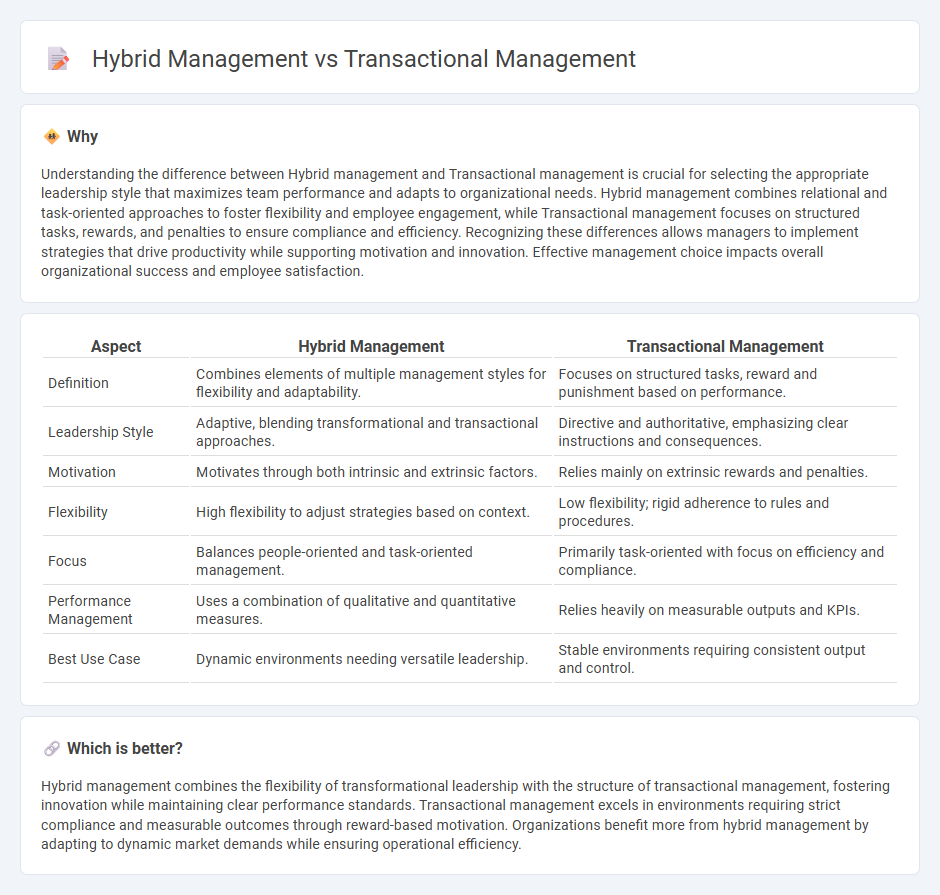
Hybrid management combines traditional transactional approaches with transformational leadership to enhance flexibility and employee engagement, focusing on both task completion and motivation. Transactional management relies on clear structures, rewards, and penalties to maintain performance and achieve short-term goals efficiently. Explore these management styles to understand their impact on organizational success and employee productivity.
Why it is important
Understanding the difference between Hybrid management and Transactional management is crucial for selecting the appropriate leadership style that maximizes team performance and adapts to organizational needs. Hybrid management combines relational and task-oriented approaches to foster flexibility and employee engagement, while Transactional management focuses on structured tasks, rewards, and penalties to ensure compliance and efficiency. Recognizing these differences allows managers to implement strategies that drive productivity while supporting motivation and innovation. Effective management choice impacts overall organizational success and employee satisfaction.
Comparison Table
| Aspect | Hybrid Management | Transactional Management |
|---|---|---|
| Definition | Combines elements of multiple management styles for flexibility and adaptability. | Focuses on structured tasks, reward and punishment based on performance. |
| Leadership Style | Adaptive, blending transformational and transactional approaches. | Directive and authoritative, emphasizing clear instructions and consequences. |
| Motivation | Motivates through both intrinsic and extrinsic factors. | Relies mainly on extrinsic rewards and penalties. |
| Flexibility | High flexibility to adjust strategies based on context. | Low flexibility; rigid adherence to rules and procedures. |
| Focus | Balances people-oriented and task-oriented management. | Primarily task-oriented with focus on efficiency and compliance. |
| Performance Management | Uses a combination of qualitative and quantitative measures. | Relies heavily on measurable outputs and KPIs. |
| Best Use Case | Dynamic environments needing versatile leadership. | Stable environments requiring consistent output and control. |
Which is better?
Hybrid management combines the flexibility of transformational leadership with the structure of transactional management, fostering innovation while maintaining clear performance standards. Transactional management excels in environments requiring strict compliance and measurable outcomes through reward-based motivation. Organizations benefit more from hybrid management by adapting to dynamic market demands while ensuring operational efficiency.
Connection
Hybrid management integrates elements of transactional management by combining task-oriented approaches like setting clear objectives, monitoring performance, and rewarding compliance with transformational strategies to enhance employee motivation and innovation. Transactional management focuses on structured processes and reward-based systems, which form the foundation for hybrid models seeking to balance efficiency and adaptability. This connection enables organizations to leverage the stability of transactional methods while fostering flexibility through hybrid management practices.
Key Terms
Leadership Style
Transactional management emphasizes structured tasks, clear goals, and reward-punishment systems to maintain performance and control within organizations. Hybrid management integrates both transactional and transformational leadership styles, balancing strict oversight with motivational inspiration to adapt to dynamic business environments. Explore the distinctions between these leadership approaches to enhance your management effectiveness.
Flexibility
Transactional management emphasizes structured processes and clear roles, prioritizing efficiency and predictability in operations. Hybrid management integrates elements of transactional and transformational styles, offering greater flexibility by adapting to changing circumstances and fostering innovation. Explore how combining these approaches can optimize organizational agility and performance.
Decision-Making
Transactional management relies on structured decision-making processes emphasizing clear rules, performance metrics, and rewards or penalties to drive employee behavior. Hybrid management combines transactional methods with transformational elements, fostering both compliance and innovation through adaptive decision-making and collaborative problem-solving. Explore further to understand how these approaches influence organizational effectiveness and leadership strategies.
Source and External Links
Transactional Leadership: Examples Leaders Should Know - This webpage explores transactional leadership, highlighting its focus on exchanging positive and negative reinforcement between leaders and employees through approaches like contingent reward and management by exception.
What is transactional leadership? - Transactional leadership is defined as a style where leaders use rewards and punishments to achieve optimal job performance, best suited for structured environments with clear goals and roles.
Defining Transactional Leadership - This article discusses transactional leadership as a structured management approach that relies on rigorous checks and balances, focusing on rewards for meeting goals and reprimands for failures.
 dowidth.com
dowidth.com